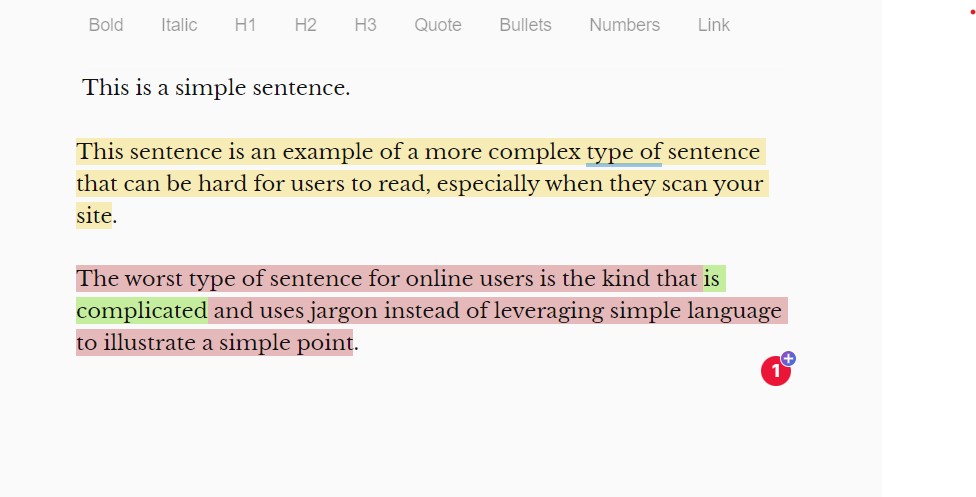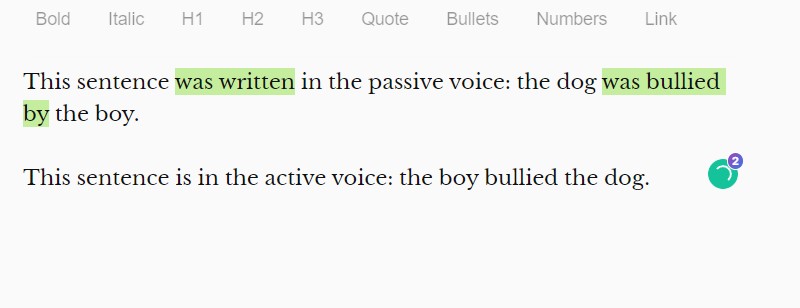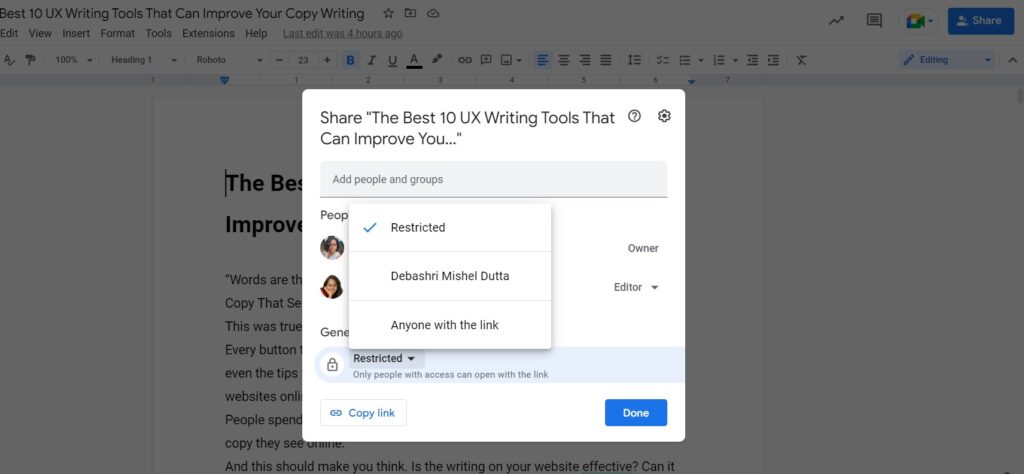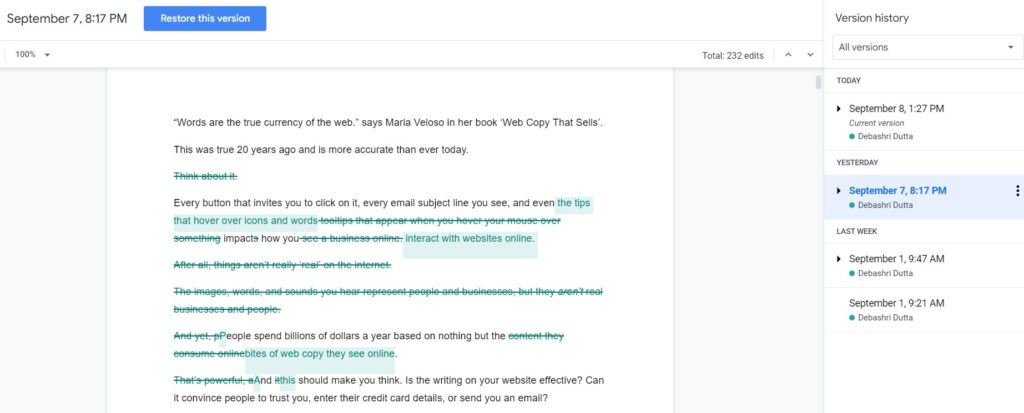“Words are the true currency of the web.” says Maria Veloso in her book ‘Web Copy That Sells.’
This was true 20 years ago and is more accurate than ever today.
Every button that invites you to click on it, every email subject line you see, and even the tips that hover over icons and words impact how you interact with websites online.
People spend billions of dollars a year based on nothing but the bites of web copy they see online.
And this should make you think. Is the writing on your website effective? Can it convince people to trust you, enter their credit card details, or send you an email?
Whether people take action depends a great deal on the copy on your site.
And this is where UX writing comes in.
UX writers, marketers, and company professionals need to leverage writing on websites to drive the most action.
In this post, we’ll share the best UX writing tools to improve your web copy.
As you keep reading, you’ll learn what the best writing apps are and make them part of your toolkit.
Let’s go!
About UX writers and what they do
In businesses with large content teams, UX writers play a critical role in rolling out content strategies. UX writers are responsible for creating content for websites and applications.
They help make user interfaces easy for people to navigate and ensure that the content is clear, concise, and user-friendly.
While a web developer builds all the elements of a website including navigation menus, buttons, page layouts, and more, a UX writer develops content that forms the basis of these design elements.
If you’re a UX writer, you’ll need to deeply understand your users so that you can write relatable and uncomplicated content.
And, you’ll also need to collaborate with the content design teams. This is because designers need to match a website or app’s design elements to the content.
When it comes to user-friendly websites, it’s always content first and design second. Never the other way around. And this means that UX writing and a UX writer’s role is critical to building a successful website.
The Best UX writing tools to polish your web content
Now that we understand what UX writers are and what they do, let’s move on to the tools writers and content strategists need to create effective content.
Here are the best writing tools that will help UX writers develop web copy that readers will engage with.
1. Hemmingway App
The first tool on our list is the Hemmingway App.
This app is one of the best writing tools for making your writing clear and concise.
Hemingway App highlights sentences to identify which sentences are hard to read. Complex sentences appear in red and you’ll know to edit them and make them simpler.


This app is also great for finding adverbs in your writing. Adverbs make your writing weak and ineffectual. By using the Hemmingway App, you’ll find it easy to find such words and remove them from your copy.
The Hemingway App also highlights sentences in the passive voice. This makes it easy to rewrite such sentences in the active voice and make your writeups dynamic.


Once the app shows you where your writing needs to improve, you can make changes in the following ways:
- For sentences that get highlighted in red, split them into two or three smaller sentences.
- Change jargon or technical words into simpler words that lay people use
- Change your tone of voice from passive voice to active voice
- Try to write in the present tense as much as you can
This type of feedback is great for beginner content writers and UX writers. You’ll get into the habit of writing clear and easy-to-read content.
The app is available on browsers for free. You can also buy the Hemingway Editor (an app for desktops) for a one time price of $19.99 and access it easily from your computer.
2. Frontitude
The next tool on our list is Frontitude. This is a great tool for managing your writing projects.
With Frontitude, you can easily create, organize, and manage your content. This tool also allows you to collaborate with other team members.
The main reason why this tool is a must-have is that it helps everyone in the content creation team work together.
You can share your ideas with the design department, the product team, and others. And you’ll get and provide feedback on each others’ works through this software.
Its design tool integration feature makes it easy to design and format your content. This means that you can integrate it with Figma, Adobe XD, or Sketch to share your design ideas with everyone.
Because everyone in your team of business has a common workspace, aligning copy and designs becomes easy-breezy.
Frontitude also has multi-language support. You can translate your copy into multiple languages and store it in your workspace.
It also allows a team to use custom fonts and has great ways to organize and arrange your copy library.
This is for you if you’re working with a large team or business and need a platform that supports a global team.
3. Google Docs
If you are looking for a simple and free writing tool, then Google Docs is the best option for you.
This online word processor has all the features a good writing tool must have. Plus, it is extremely easy to use.
With Google Docs, you can easily create, format, store, and distribute your content.
It’s very secure since you can restrict who can view your content. And it’s available on web browsers – so there is no need to download any apps. Unless you want it on our mobile device.
You can also collaborate with other team members in real time. Your team can leave comments, make edits or suggestions, or change your copy. And you can restrict the kind of access other people have to your documents. So only you can edit your work while getting relevant feedback from others.


Another reason why it’s especially useful is that it has a feature that allows you to track changes. So, if someone else edits your work, you’ll see exactly where these changes were made.


Another great thing about this software is that it saves your work automatically. So, you don’t have to worry about losing your work.
Google Docs is a reliable all-purpose document tool that you’ll use. So, start working with it to manage your content with ease.
4. Thesaurus.com
For content creators, word choice is extremely important. The words you use in your writing will determine the tone of your writing.
A website’s user flow and design will depend on the copy UX writers create. As a result, you’ll need to be mindful of the words you choose while creating your content.
That’s why it is essential to use the right words that convey the message you want to deliver. And Thesaurus.com will help you with this.
Thesaurus.com is a platform that will generate synonyms for any word you need. This online tool will generate multiple alternatives for a single word.
Another product of Thesaurus .com is ‘Grammar Coach’. Grammar Coach is an AI-backed platform that focuses on correcting your spelling, punctuation, and other grammar mistakes.
While Thesaurus.com is a wonderful tool, there are equally powerful alternatives you should check out. Here are some of them:
- Related Words – This website does not give you synonyms or alternative words. But it does give you words that are tangentially related to one. It’s a great tool if you can’t remember a specific word but only one related to it. You’ll get interesting word ideas that will help you in the UX design process.
- WordHippo: Like Thesaurus.com, WordHippo is an online tool that will give you similar words to the one you’re using right now. What’s great about it is that it can do much more – it can give you rhyming words, words ending with specific letter combinations, and more. You never know the kind of help you’ll need finding the right words, but WordHippo is sure to help you.
5. Readable
Next up is Readable a must-try tool for any writer. Whether you’re a content writer, UX writer, or novelist, anyone can use this tool to improve their writing.
As the name suggests, this tool makes your writing more readable. The main purpose of this app is to check the readability of your writing.
But what is readability and why does it matter? Let’s find out.
Readability refers to how easy-to-read your blog posts or web copy are. Generally, a very readable piece of writing reflects high-school reading abilities.
Making content readable at a high school level (and not higher) is important because your audience is impatient. Your readers aren’t going to scroll through every piece of content they find with care. They’re going to skim.
And they want to understand what they read in a flash. They do not want to reread or decipher complex writing. Keeping your writing at a high school level makes it easy to scan writing in seconds.
Readable may seem like Hemmingway App at first glance, but it offers a lot more.
This tool has everything from tone analysis and sentiment analysis to grammar checking. And it can be used by anyone who wants to make their writing more readable.
With Readable, you can analyze the readability of your writing. As a UX writer, the clarity of your writing is extremely important. The Readable app lets you analyze documents and websites.
And you can integrate it using its API to make it part of your workflow.
This tool will help you score your writing. Plus, give you tips on how to make your copy more straightforward and understandable for developers.
6. Miro
Miro is one of the best tools for UX that a design team could have. This online whiteboard platform helps you to share your ideas with others easily.
Miro can be used by UX writers, content strategists, and UX designers.
This tool has features like online chat and video calls that make collaboration easy. You can use this software for brainstorming, wireframing, or even note-taking.
Miro also has a plugin that allows you to integrate it with Google Docs, Adobe, etc. This way, you can easily share your content with others.
It also comes with resources like pre-built templates. You can build your projects based on these templates without starting from scratch.
Lastly, Miro also offers a free plan. So, if you are on a budget, this tool is perfect for you.
7. InVision Write App
InVision app is a well-known platform for UX designers. But it also has a writer’s version that’s meant to support UX writers, content writers, and copywriters.
It helps writers collaborate with the design team seamlessly.
Developers and designers use the Studio app by InVision to design web pages and applications.
With the new InVision app for writers, a UX writer can simply add copy while in the Write mode. And this will reflect in the Studio version. Developers can easily incorporate the new copy into the web design.
InVision Write is an app for all writers and is not just limited to UX writers. This app helps you to get feedback from others and allows you to assist in the design process. This means fewer disruptions in the design process and faster delivery.
InVision Write is available for free. But, if you want to use the premium features you will have to pay $10 per month.
8. Figma
Figma is another well-known design tool. UX designers use this design software to create user interfaces, wireframes, and prototypes.
However, it is also an important tool for UX writing. The tool has adapted to the needs of the market and allows writers to have a voice from the initial stages of the design process.
This tool is not a text editor. Instead, it’s a design tool where the writing process overlaps the existing visual layers in a design project. This means that you’ll be working on the Figma design platform – not a separate document editor.
Heads up – there is a learning curve to using Figma effectively for UX writing. However, the platform does provide useful teaching material to help you along the way.
If you’re looking for simple UX writing tools to assist in writing general copy then this is not a tool for you. However, learning to use Figma will boost your skills if you’re part of a product design team or a design agency.
Figma also has a brainstorming and whiteboard-style tool called FigJam. You can work on both Figma and FigJam and move your content from one to another. You can also create annotations and use strings to edit copy in the actual design.
You can also share your copy with the marketing team and other people in the organization who don’t want to use Figma. Just use its CopyDoc Text Kit tool to export your files to a spreadsheet format.
This UX writing tool is somewhat complex, but this factor works in its favor. It is a collaborative tool that is great for designers, writers, and developers who need to work together.
And it’s worth the effort to learn how to use it – if you want to streamline building a powerful website.
If you love working with design tools and have the technical expertise, then Figma is great for you.
It’s available for free. But, if you want to use its premium features, you will have to pay $12 per month.
9. Notion
Strictly speaking, Notion is an organization and productivity tool, not a specialized writing tool. But many designers and writers use Notion as a valuable tool to organize their work.
Notion is a gorgeous all-in-one tool that has the following features:
- Kanban boards
- Gantt charts
- Note-taking features
- To-do lists
- Teamspaces for departments and teams
- Documents
- Shareable, public ‘websites’ built on Notion
It has many more features but these are the main ones a UX writer might work with.
The platform is intuitive, user-friendly, and has a stunning user interface. You can’t help but want to write on it.
So, how do you use a general note-taking and productivity tool for UX writing? Here are a few ideas:
- Create and share a portfolio of your work
- Save and easily view websites you save for inspiration
- Jot down notes and ideas on the go using the mobile application
- Create a Kanban board and track your task progress
- Create personas and user journeys and save them on Notion
- Share your content with your team and get feedback and suggestions
Overall, Notion is a brilliant tool to support your UX writing and learning. Use the personal version for free or buy the small business version for your team. The investment will be more than worth it because it helps you stay on track and meet your goals quickly.
10. Grammarly
And the final one on our list is Grammarly. Grammarly is an AI-based tool that corrects grammar, spelling, and punctuation. And it does all this for free.
If you’re willing to pay for its premium edition, Grammarly will help you finetune the tone of your content and correct less evident mistakes.
This tool is used by writers of all levels, from beginners to professionals. It is also available as a plugin for Google Chrome, Firefox, Edge, and Safari. Plus, there is also a Grammarly Keyboard app for Android.
Grammarly is a basic but necessary tool for UX writers.
Writing is hard as it is. Having a smart AI partner to correct mistakes will save you time and energy so that you can focus on being more creative.
The premium version of Grammarly starts at $11.66 per month.
Be a better UX writer with the best tools for UX writing
So, these are some of the top UX writing tools you can use to improve your writing skills.
Which ones should you choose?
You’ll figure this out when you look at your goals and needs. If you’re an individual writer who needs helpful tools to write on and save your content, then Notion and Google Docs might be enough. Along with Grammarly, Thesaurus.com, and Hemmingway App.
But if you’re part of a design agency or a design team, then you should work with Figma, Readability, and Frontitude. These tools are necessary to support group collaboration and sharing real-time feedback. With these tools, your design process will move faster – making for happier bosses and customers too.
Do you know about any other UX writing tool that has helped you in your writing journey? Let me know in the comments.







